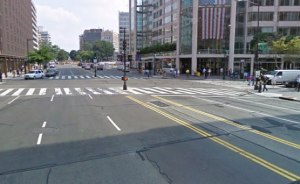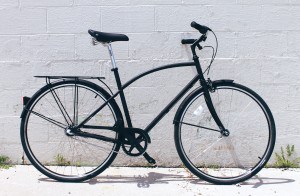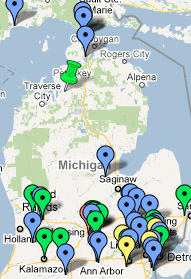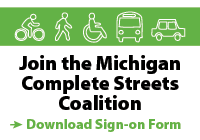You are currently browsing the tag archive for the ‘Michigan Municipal League’ tag.
If you have a problematic section of road in your community, here is a great chance to make your solution heard. Check out this design contest from Let’s Save Michigan (LSM). Submissions are due October 18th, no design experience necessary. You could win a brand new, Michigan-made bike!
Let’s Save Michigan is giving away a brand new, Michigan-made bicycle for the best design idea for a slice of Michigan roadway. LSM’s Highways for Habitats design competition asks participants to: 1. Identify a road that is a drain on its community, and; 2. Reimagine that road so that it works better for the community it bisects.
The contest seeks, for example, those five-lane roads that divide a quaint downtown into isolated halves, or separate a neighborhood from a public park—those roads that make their surroundings feel unsafe to pedestrians and bicyclists, families with kids and seniors waiting for the bus. Entries should imagine a new version of that street—one that works for all kinds of users, and that encourages community health and economic development.
Contest participants are asked to submit one photo of the site they select, along with their design and a few words about why it makes sense, at this contest submission page (http://www.letssavemichigan.com/highways-for-habitats-entry-submission/) by Friday, October 18. The public will vote online to select the finalists, with the grand prize and a runner-up to be selected by a panel of judges.
A few words on what to enter: LSM is NOT necessarily expecting professional engineer-caliber drawings. Entrants may simply draw a picture, snap a photo of it with a camera phone and submit that. Everyone has a shot at the prize, as long as the entry effectively gets across the brilliant idea.
To help generate ideas, LSM has been collecting examples from all over the world on the Let’s Save Michigan blog for the past few months in a Highways for Habitats blog series. LSM also has compiled resources from around the country about good road design. Take a look and get inspired.
Entries can be uploaded here: http://www.letssavemichigan.com/highways-for-habitats-entry-submission/.
It’s been done all over the world: Roads can conduct vehicles while helping foster community and economic development. With the help of contest participants, Let’s Save Michigan plans to show Michigan’s leaders how it can be done.
LSM would like to thank the grand prize sponsor, Detroit Bikes! and the runner-up prize sponsor, Cross Country Cycle!
The Michigan Municipal League’s Let’s Save Michigan initiative is a citizen engagement and advocacy effort that promotes smart policies to build a restored Michigan—a state with good jobs, vibrant cities, accessible transportation, and first-rate cultural centers.
Let’s Save Michigan advocates for policies and practices that support, revitalize, and promote Michigan’s cities. For decades, disinvestment and our auto culture have contributed to the decline of our great public spaces. But thankfully, there is a new understanding in many communities and among many of our leaders that we need to reinvest in our public spaces, and rebuild the public amenities that make people choose to live, work, and play in Michigan’s cities of all sizes. For this contest, the nonprofit Let’s Save Michigan asked stakeholders across Michigan to find an underutilized space in their community—an alley, a pocket park, a vacant lot—and then work together with members of the community to create and design a plan to turn that underutilized space into a welcoming, vibrant public place.
###

Don’t miss the next Prosperity Agenda focused on Complete Streets in Michigan. Listen here today or tune in at 7 p.m. tomorrow, June 25th, for those who get NewsTalk 760 WJR Radio.
Dan Gilmartin of the Michigan Municipal League and co-host Dustin Block, news director for MLive Detroit, talk about Complete Streets and how these projects are taking hold in Michigan and transforming our communities with guests Suzanne Schulz, Planning Department Director for the City of Grand Rapids, Economic Development Program Manager for the Woodward Avenue Action Association, Jason Fowler, and John Lindenmayer, Advocacy and Policy Director for the League of Michigan Bicyclists and co chair of the Michigan Complete Streets Coalition.
Reported by Paul Lamoureux, Northville Resident
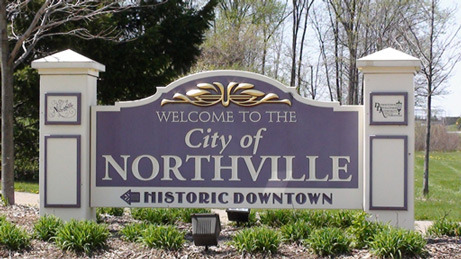
With unanimous accord, the Northville City Council adopted a complete streets resolution at its regular meeting on Monday, June 20. The measure was hailed by its author and initial proponent, City Manger Patrick Sullivan, as a necessary first step toward the establishment of a comprehensive non-motorized master plan designed to link Northville residents with nearby communities of Novi and Plymouth. It turns out Mr. Sullivan has prior, job-related experience with non-motorized infrastructure and has experienced first hand the positive community and economic benefits when a community accommodates all modes of transportation.
Several interesting facts emerged during the discussion of the resolution. Novi, with its own complete streets resolution, was cited as an example of a community benefiting from its long-standing non-motorized plan whose residents have long sought better access to commercial downtown Northville. Residents of both communities also seek a method to bike and walk to nearby Maybury State Park, a presently unsupported route and primary goal for the future. Finally, some expressed support for a better, biker-friendly connection between downtown Northville and Hines Park terminating at the city’s southern border.
A pair of Northville resident League of Michigan Bicyclists (LMB) members first approached the City Manager just a few short months ago to communicate the complete streets message. The city then availed itself of the resources provided by micompletestreets.org and the Michigan Municipal League. Upon passage of the resolution, City Council expressed their interest in further support from LMB in the drafting and implementation of the non-motorized master plan and expressed their gratitude for their leadership thus far in the process.
By Scott T. Clein, P.E., LEED AP
Reposted with permission from the Michigan Municipal League’s May/June issue of The Review magazine
Pedestrian-friendly … walkable … You’ve most likely heard, and used, these terms when describing the future vision of your community. You’ve also likely heard about Complete Streets and assumed it was the same thing.
Technically you’re right…and wrong. While Complete Streets initiatives do improve the walkability of roadways, the concept includes so much more. Before your community takes a dive into the Complete Streets waters, you need to understand whether or not you’ll need a life vest.
In 2010, Michigan joined a growing list of states that enacted legislation related to Complete Streets. Two bills passed that added the phrase to the legislative vernacular and requires the Michigan Department of Transportation to create a Complete Streets policy that serves as a model for communities.
But what is the concept really all about? Below are common definitions that should be considered during Complete Streets planning and discussions.
COMPLETE STREETS is a movement that designs and operates roadway corridors promoting safe access for all users. Roadways, therefore, should accommodate vehicles, transit, bicyclists, and pedestrians of all ages and abilities.
UNIVERSAL ACCESSIBILITY emerged as an offshoot of barrier-free design. It’s the idea that good design must take into account the age and ability of all users from the beginning, even if it means exceeding minimum standards to allow for a better use of space.
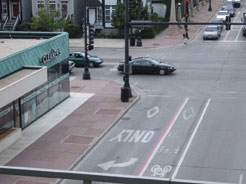 GREEN STREETS encourages sustainability in the design and construction of roadways by using the latest best management practices, such as rain gardens for improving stormwater quality.
GREEN STREETS encourages sustainability in the design and construction of roadways by using the latest best management practices, such as rain gardens for improving stormwater quality.
LIVING STREETS states pedestrians must be properly included in transportation designs. It goes beyond simply adding sidewalks to include active use of the corridor, such as outdoor dining and sales, and neighborhood festivals.
With a clearer understanding of Complete Streets improvements, here are five common myths that may get in the way of planning and implementation.
Myth 1: It’s expensive.
Designs in line with Complete Streets philosophies don’t have to cost a lot, especially when included in annual capital improvement projects. Most communities have existing funding for road maintenance and related upgrades. When resurfacing a roadway, for example, implement bike lanes for little to no added cost.
This piece-by-piece approach may seem out of place when attempting to promote connectivity, but it mimics road maintenance approaches and allows the largest benefits from shrinking budgets.
Myth 2: On-street bike lanes are unsafe.
On the contrary, studies show that on-street bike lanes, when properly marked and signed, are safer for bicyclists and pedestrians than sidewalks.
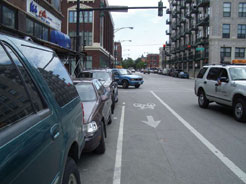 The Transportation Research Board published a study by William Moritz at the University of Washington referencing the Relative Danger Index, which measures bicycle-accident frequency to distance traveled. A higher number represents a greater danger. Sidewalks have an RDI of 5.30 while streets with dedicated bike lanes have an RDI of 0.50.
The Transportation Research Board published a study by William Moritz at the University of Washington referencing the Relative Danger Index, which measures bicycle-accident frequency to distance traveled. A higher number represents a greater danger. Sidewalks have an RDI of 5.30 while streets with dedicated bike lanes have an RDI of 0.50.
Clearly, it’s a misperception that bicyclists are at greater risk on roadway bike lanes. This on-street myth is also perpetuated by the notions that drivers won’t change their driving habits in the presence of a bicyclist and that roadways are only built for vehicles.
Myth 3: It’s only for urban communities.
Urban areas will undoubtedly benefit the most from Complete Streets improvements because of dense pedestrian activity. However, let’s imagine a rural suburban community that has, during the last 30 years, shifted from primarily agricultural land uses to single-family residential developments.
Typically, these developments are islands surrounded by farmland with intermittent access to an open-shoulder country road. They are not truly connected with other neighborhoods and do not allow residents to safely walk or bicycle outside of their subdivision.
Now imagine the same two-lane country road with a paved bike lane along the shoulder. Then add a large shared-use pathway beside the right-of-way line for pedestrians and less-accomplished bicyclists. The result is safely linked subdivisions and a community that is making a dynamic statement about its values.
Myth 4: It negatively impacts traffic flow.
Well…yes, it might. Accommodations for pedestrians and bicyclists may increase driver delay or reduce vehicle speeds. But this is not always a bad thing.
Pedestrian spaces and dedicated bike lanes can create an inviting atmosphere. In addition to promoting a healthier lifestyle, this can help foster the spirit that cool communities seem to have. This so-called “it” factor entices people to live in a neighborhood or city center and directly translates into positive community economic development and financial sustainability.
While there can be repercussions, such as altered traffic patterns that negatively impact surrounding streets, transportation engineers must look at their network holistically and reconsider pavement geometry to encourage safe driving.
Myth 5: “We ARE a walkable community, so this won’t change our plans.”
Some communities have embraced the Complete Streets concept. Still, disagreements between planning and engineering staffs continue largely because of these myths. Simply being walkable does not make a Complete Street. What about ADA compliance and other street amenities? Significant opportunities spring from combining the power of the planning, engineering, and economic development areas of local government.
Consider an engineering department that actively promotes the construction of smaller roadways to incorporate bike lanes, wide sidewalks, and universal design principles. What if the planning department aligns these improvements with zoning ordinances to encourage mixed-use developments with outdoor dining and pedestrian-scale amenities? Now, the economic development director has added firepower to actively recruit businesses and developments. Uniting these groups can unleash the powerful potential to positively impact a community.
This last point is the overarching benefit that must be understood about Complete Streets. When properly infused into a community, a Complete Streets mentality can help unite economic development, land planning, and transportation engineering for bettering the overall quality of life. All community leaders would benefit from understanding the definitions and implications, but also keeping in mind the myths discussed. With the proper perspective and conviction, Complete Streets can make every Michigan community a better place to live.
Giffels-Webster
Giffels-Webster Engineers, Inc. is a civil engineering, surveying, planning, and landscape architecture firm with a 55-year history of serving municipalities and governmental agencies throughout Michigan.
For more on Giffels-Webster, visit www.giffelswebster.com
Scott T. Clein, P.E., LEED AP is an associate at Giffels-Webster.
You may reach him at 313-962-4442 or [email protected].
From our partners a the Michigan Municipal League:
 This afternoon at the League’s Capital Convention, representatives of the cities of Ferndale, Midland and Mount Pleasant shared experiences from the front lines of efforts to complete their communities’ streets. The three cities are in different stages of implementation, showing the diversity of approaches available to Michigan communities under Michigan’s Complete Streets legislation.
This afternoon at the League’s Capital Convention, representatives of the cities of Ferndale, Midland and Mount Pleasant shared experiences from the front lines of efforts to complete their communities’ streets. The three cities are in different stages of implementation, showing the diversity of approaches available to Michigan communities under Michigan’s Complete Streets legislation.
Ferndale Councilwoman Melanie Piana shared her perspective as an elected official who spearheaded the successful efforts to adopt a Complete Streets ordinance. She stressed the importance of building a support team, educating stakeholder groups and strengthening partnerships. She encouraged local government staff and officials to bike their communities to see first-hand the strengths and weaknesses of the network. Complete Streets policy discussions can be a catalyst to coalesce disparate resolutions, policies and processes already in existence within the local government. Ferndale adopted an ordinance but has not yet created a non-motorized transportation plan.
Keith Baker, Midland’s Planning Director, shared a different story about the challenges creating political will for a Complete Streets ordinance. He advocated working incrementally if necessary, starting with a local task force and then building a non-motorized plan. Midland recently adopted a non-binding resolution that is advisory in nature but requires review of all new construction projects.
Jeff Gray and Rich Morrison from Mount Pleasant’s Planning and Economic Development departments showcased examples of innovative projects completed in their city to reduce traffic speeds and increase pedestrian safety without a formal Complete Streets policy in place. They also provided recommendations for dealing with the challenges of redeveloping a state trunkline running through a downtown.
The League’s Complete Streets page provides examples resolutions, policies and other background information.
Luke Forrest is Project Coordinator with the Center for 21st Century Communities. Contact him at 734-669-6323 or [email protected].
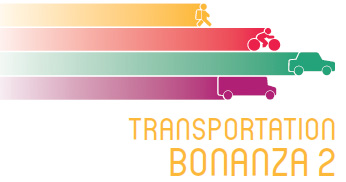 The Michigan Association of Planning, in partnership with the Michigan Department of Community Health, Michigan Department of Transportation, Michigan Safe Routes to School program, Michigan Municipal League, and the MI Chapter – Congress for New Urbanism, is launching its second annual Transportation Bonanza! Slated for December 8 (Lansing Center) and 9th (Lansing Radisson), this comprehensive, multidisciplinary workshop provides the programming necessary to integrate land use and transportation policies with health and mobility agendas, and responds to the recent passage of complete streets legislation, which made Michigan the 14th state to embrace this integrated approach to planning, design and construction of transportation networks which provide safe, attractive and comfortable access for ALL users, from bicyclists and pedestrians, to the elderly and disabled, busses and trains, and the automobile.
The Michigan Association of Planning, in partnership with the Michigan Department of Community Health, Michigan Department of Transportation, Michigan Safe Routes to School program, Michigan Municipal League, and the MI Chapter – Congress for New Urbanism, is launching its second annual Transportation Bonanza! Slated for December 8 (Lansing Center) and 9th (Lansing Radisson), this comprehensive, multidisciplinary workshop provides the programming necessary to integrate land use and transportation policies with health and mobility agendas, and responds to the recent passage of complete streets legislation, which made Michigan the 14th state to embrace this integrated approach to planning, design and construction of transportation networks which provide safe, attractive and comfortable access for ALL users, from bicyclists and pedestrians, to the elderly and disabled, busses and trains, and the automobile.
Communities that create a culture that embraces transportation options for all users not only expands access to services and encourages healthy lifestyles, but also lowers traffic congestion, attracts and retains residents and businesses, supports mixed use and compact development, promotes economic development, and improves equity in transportation. Learn how YOUR community can enhance its livability, add value to residents, and attract investment by integrating elements that create vitality.
Learn what you can do locally to implement policies and programs that can transform your community, from DAY 1’s national livability experts Michael Ronkin, Harrison Rue, and Scott Windley to Day 2’s ITE Manual authorities Phil Caruso, Brian Bochner and G. Wade Walker.
Whether you are seeking a multi dimensional, motivating, and practical experience, or a technical guide for innovative applications - or BOTH - you will find value, inspiration and skills at MAP’s TB2.
Follow this link for online registration and to view the program brochure, with details about keynote speakers, session descriptions, and mobile workshops.
The Michigan Municipal League (MML) is asking folks to sign a petition of support for Complete Streets on their Let’s Save Michigan website. They recently featured the Complete Streets design principle at their Capitol Conference, and brought national walkability expert Dan Burden to a number of Michigan communities in February.
We are extremely pleased to see that the Let’s Save Michigan blog is asking people to contact their legislators to support HB 6151 & 6152. While MML has been supportive of the idea of Complete Streets, they have not officially thrown their support behind these specific bills. MML’s testimony last week before the House Transportation Committee stated that they only support these bills “in concept.”
We expect the House Transportation Committee to vote on these bills this Thursday, June 17. We’ll keep you updated.
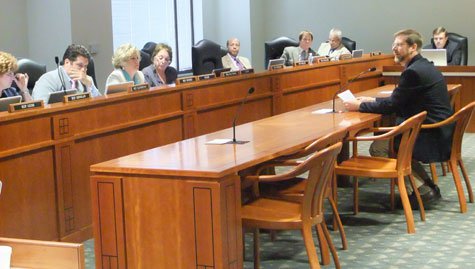
Michigan Complete Streets Coalition member, Norm Cox of the American Society of Landscape Architects used his testimony to state that HB 6152 and 6152 is "working to make amends for the lopsided transportation investments of the last 50-60 years," adding, "it's not taking money away, but redistributing it based on changing priorities."
The second House Transportation Committee hearing on Complete Streets legislation, HB 6151 and 6152, saw the room once again packed with supporters of the policies. The legislation - which seeks to move Michigan away from auto-centric road designs and meet the needs of all roadway users - has attracted strong support from a broad range of advocates. A few of the groups represented at today’s hearing included: The American Heart Association, Crim Fitness Foundation and Citizens for a Safe Community.
The coalition would like to extend thanks to all those who spoke at the meeting today, as well to those that offered written testimony. Chairwoman Byrnes (D - Dist. 52) indicated she plans to hold a vote on the bills next week, and with some organizations like SEMCOG and MML still supporting the bill in concept only, it is important that the committee members continue to hear vocal support for these specific policies.
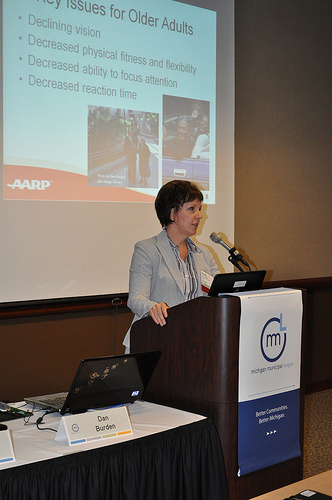
Michigan Complete Streets Coalition partner Karen Kafantaris of AARP presents on Complete Streets at the Michigan Municipal League's 2010 Capitol Conference held April 13 -14 in Lansing.
A packed room of 100+ engineers, planners and politicians attended the Complete Streets workshop at the Michigan Municipal League’s 2010 Capitol Conference held April 13 -14, 2010 in Lansing.
The panel included John Switalski (D - Warren) who spoke on pending statewide Complete Streets legislation that he plans to introduce this spring. Nationally recognized walkability expert Dan Burden also joined the discussion, as did Lansing City Council Women Jessica Yorko who recounted Lansing’s recent citizen driven Complete Streets initiative which led to the adoption of the first Complete Streets ordinance in Michigan. Michigan Complete Streets Coalition partner Karen Kafantaris of AARP rounded out the panel as she made the case for why Complete Streets are essential to mobility needs of aging Americans.
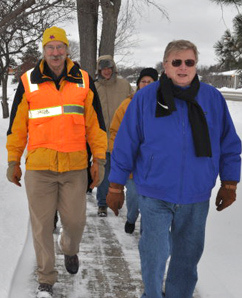 Earlier this month, our friends at the Michigan Municipal League hosted a walkability workshop with nationally renowned expert Dan Burden. In addition to the full day workshop, Dan Burden facilitated walking audits in several Michigan communities. Below are links to the workshop materials and media coverage the various events received.
Earlier this month, our friends at the Michigan Municipal League hosted a walkability workshop with nationally renowned expert Dan Burden. In addition to the full day workshop, Dan Burden facilitated walking audits in several Michigan communities. Below are links to the workshop materials and media coverage the various events received.
Dan Burden’s Workshop Materials:
Part 1: Health and Sustainability
Part 2: Placemaking
Part 3: Transportation Tools
Recent Stories, Photos and Posts About Walkability Audits with Dan Burden:
- Walkability Expert Dan Burden Visits Lapeer (Inside 208 blog)
- Lathrup Village Treks towards a Walkable Community (21st Century Community blog)
- Community Design Strategies to Bolster Local Economies (MML Newsroom)
- Leaders Aim to Make Linden More Walker-Friendly (Tri-County Times)
- Walkability Tour Could Yield Changes in Downtown View (Lapeer County Press)
- Changes Could Be Near in Downtown View (Lapeer View)
- Lathrup Village Explores a More Walkable Future (Southfield Sun)
- Michigan Municipal League Hosts Two Events on City Revitalization (Inside 208 blog)
- Photos of Revitalization Meetings in Lansing (Flickr)
- Photos of Dan Burden’s visits to Linden, Lapeer and Lathrup Village (Flickr)
- Facebook Photos of Dan Burden’s Michigan Visits (Facebook.com/mml)
Also, please don’t forget about MML’s upcoming workshop on Complete Streets during their Capital Conference on April 13-14.
“You Complete My Streets” Workshop at Capital Conference
Attend this session to learn about Michigan’s Complete Streets initiative, project planning that incorporates all forms of transportation. As you’ll hear from experts and local officials who have already adopted this approach, it IS possible to build new roads around motorists, bicyclists, transit systems, walkers, etc. without breaking the bank. Register by March 15 for the early bird rate.


